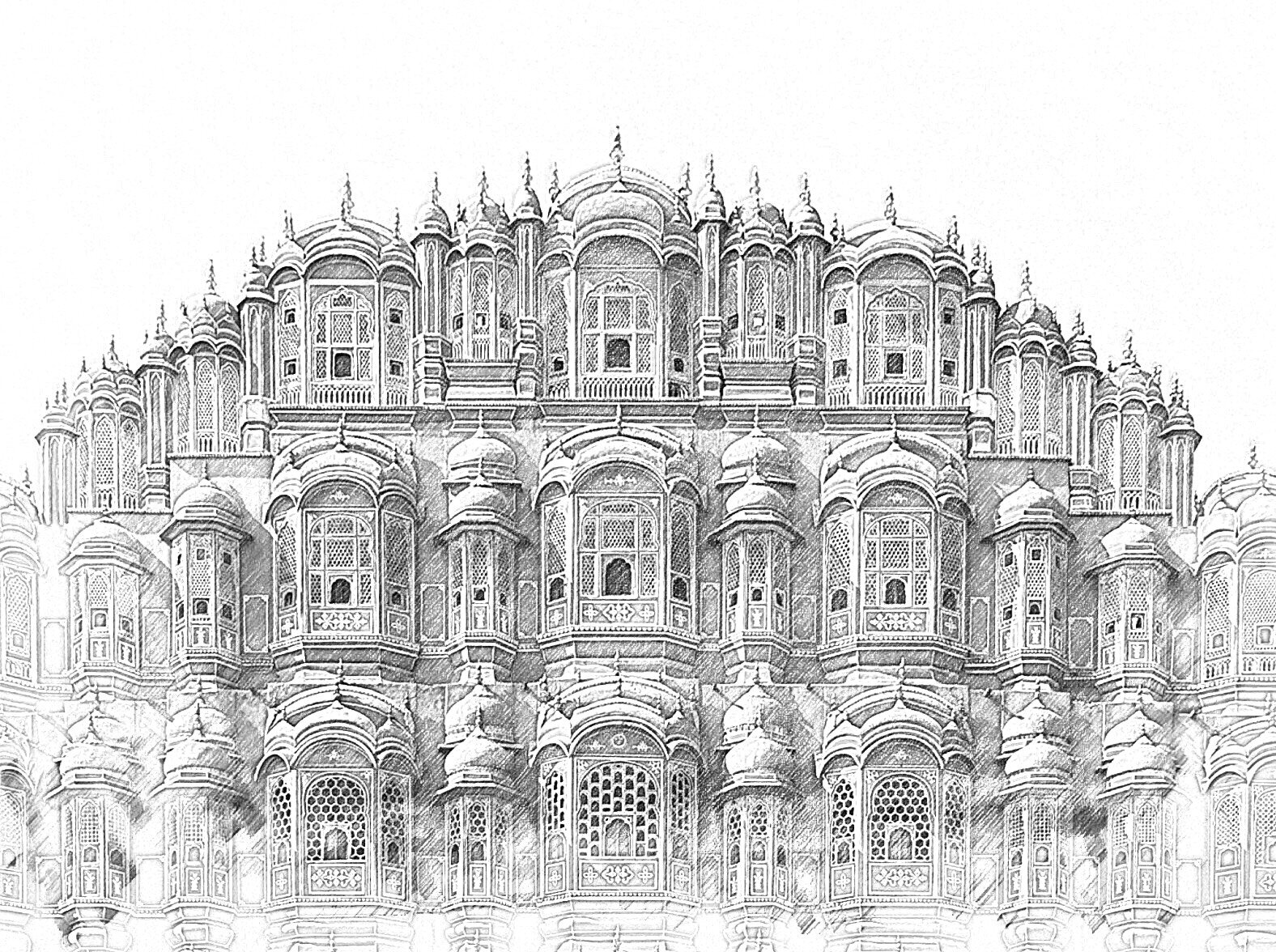Hawa Mahal
The Palace of the Winds
Jaipur, India
We did a fascinating sojourn through Rajasthan, the land of Kings, in the winter of 2015. We travelled through Jaipur, Jodhpur, Jaisalmer, the Great Thar Desert and the Ranthambhore Tiger Sanctuary and saw some of the most impressive buildings and architecture in the world including the Mehrangarh Fort, Jaswant Thada, Jaisalmer Fort, Amer Fort and of course the Hawa Mahal among many others.
Jaipur's Hawa Mahal (The Palace of the Winds) is undoubtedly one of the most distinctive monuments in India. It is certainly one of the most iconic landmarks in Jaipur. Located at Badi Chaupar (Big Square), in the walled Old City of Jaipur, it is part of India’s popular Golden Triangle Tourist Circuit and can be easily accessed by rail, road or air.
Made with red and pink sandstone, the palace sits on the edge of the City Palace, and extends to the zenana (women’s chambers). The building's evocative facade, with its multitude of latticed windows, never fails to arouse curiosity. These windows with their fine latticework were meant to act like veils - a “purdah” for the royal ladies. Custom dictated that royal women shouldn’t be seen by the public and they were also not allowed to venture out into the streets. What's also interesting, is that the Hawa Mahal is supposedly the world's tallest building without a foundation. It is said to have been constructed with a slight curve to make up for not having this strong base.
The palace was built in 1799 by Maharaja Sawai Pratap Singh, who ruled Jaipur from 1778 to 1803, the grandson of Maharaja Sawai Jai Singh II, the founder of Jaipur. Lal Chand Ustad was the architect of this unique structure. Built in red and pink sandstone, in keeping with the décor of the other monuments in the city, its color is a full testimony to the epithet of "Pink City" given to Jaipur. Its unique five floors facade is akin to the honeycomb of a beehive with its 953 small windows called Jharokhas (some are made of wood) decorated with intricate latticework - an openwork framework consisting of criss-crossed pattern of strips of building material, typically wood or metal, formed in a grid or weave. Latticework in stone or wood from the classical period is also called transenna.
The original intent of the lattice design was to allow the royal ladies to observe everyday life and festivals celebrated in the street below without being seen, since the strict rules of "purdah" forbade them from appearing in public without face coverings. This architectural feature also allowed cool air to pass through, thus making the whole area pleasant during the high temperatures of summer. Many people see the Hawa Mahal from the street view and think it is the front of the palace, but in reality it is the back of that structure.
The facade of the Hawa Mahal is believed to resemble Lord Krishna's crown, as Maharaja Sawai Pratap Singh was an ardent devotee. The Hawa Mahal is also said to have been inspired by the Khetri Mahal of Jhunjhunu, in the semi arid Shekhawati region of northeastern Rajasthan, built in 1770 by Bhopal Singh. It's regarded as a "wind palace" as well, although it has pillars to facilitate air flow instead of windows and walls.
The palace is a five-story pyramidal shaped monument that rises to about 50 feet (15 m). The top three floors of the structure have the width of a single room, while the first and second floors have patios in front of them. The front elevation, as seen from the street here, is like a honeycomb with small portholes. Each porthole has miniature windows and carved sandstone grills, finials and domes. It gives the appearance of a mass of semi-octagonal bays, giving the monument its unique façade. The inner face on the back side of the building consists of chambers built with pillars and corridors with minimal ornamentation, and reach up to the top floor. The interior of the Mahal has been described as "having rooms of different coloured marbles, relieved by inlaid panels or gilding; while fountains adorn the centre of the courtyard".
The Hawa Mahal is also known as the chef-d'œuvre of Maharaja Jai Singh because of the elegance and built-in interior of the Mahal. The breeze passing through the small windows of the façade cooled the chambers and was enhanced by the fountains provided at the center of each of the chambers. Although the Hawa Mahal is made out of red and pink sandstone, its exterior was painted pink in 1876, along with the rest of the Old City. Prince Albert of Wales visited Jaipur and Maharaja Ram Singh decided this would be a great way to welcome him, as pink was the color of hospitality. This is how Jaipur became known as the "Pink City". The painting still continues, as the pink coloring is now required to be maintained by law.
Panch Mahal, Fatehpur Sikri
To access the Hawa Mahal, one needs to go around the back and approach it from the city palace side. The entry to the Hawa Mahal from this side is through an imperial door. It opens into a large courtyard, with double-storeyed buildings on three sides, with the Hawa Mahal enclosing it on the east side. An archaeological museum is also housed in this courtyard.
The top two floors of the Hawa Mahal are accessed only through ramps. The Mahal is maintained by the archaeological department of the government of Rajasthan.
The Hawa Mahal’s cultural and architectural heritage is a true reflection of a fusion of Hindu Rajput architecture and Mughal architecture. The Rajput style is seen in the form of domed canopies, fluted pillars, lotus and floral patterns while the Mughal style is evident in its stone inlay filigree work and arches. A similarity can be drawn with the Panch Mahal at Fatehpur Sikri, pictured here on the left.
The Panch Mahal - five level palace - was commissioned by emperor Akbar in 1571 and also stands close to the zenana, supporting the theory that it was used for entertainment and relaxation An extraordinary structure employing the design elements of a Buddhist Temple; entirely columnar, consisting of four stories of decreasing size arranged asymmetrically on the ground floor, which contains 84 columns. These columns originally had jaali (screens) between them, support the whole structure. Once these screens provided purdah (cover) to queens and princesses on the top terraces enjoying the cool breeze and watching splendid views of Sikri fortifications and the town nestling at the foot of the ridge. More on this in a later blog.
The Hawa Mahal stands tall and calm in the chaos and bustle of the Johari Market. Puppet and handicraft shops crowd the streets and one can usually find a snake charmer sitting opposite the palace.
In closing some interesting facts about the Hawa Mahal:
The name Hawa Mahal, translating to “the Palace of the Winds“, is attributed to the breeze that circulates through the 953 Jharokhas.
The design of the facade is akin to the honeycomb of a beehive.
While not tall in comparison to the skyscrapers of the world, the Hawa Mahal is considered the tallest building without a foundation.
‡‡‡‡‡
What an absolutely amazing time we live in! On 29th May I shared this blog on the Hawa Mahal and yesterday I discovered this fantastic watercolor on one of the comments. This is a 51x36cm watercolor by Simonida Filipova Kitanovska, a professional painter from Skopje, North Macedonia. She visited in January 2020 for the 6th International Watercolor Festival held in Kota, Rajasthan. With her permission I am sharing it here.
Imagine that!!!
‡‡‡‡‡
Related Posts






